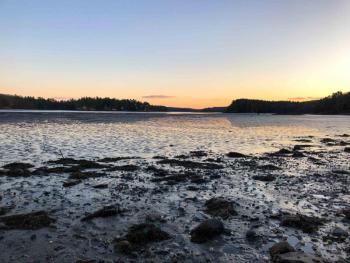Shellfish study highlights changes in Damariscotta River
The rich ecosystem of the Damariscotta River estuary still holds many mysteries. Some of its most visible residents – oysters, alewives, seals and birds – are counted regularly. But until this year, the wild shellfish of the upper estuary have gone uncensused.
That changed in 2019, thanks to a collaboration between the Joint Shellfish Committee of the towns of Damariscotta and Newcastle and the University of Maine Darling Marine Center. “We haven’t had information on the shellfish resource before,” said Damariscotta Town Manager Matthew Lutkus. “But we have heard from harvesters that clams are declining, and the committee wanted to do something about it.”
With a grant from Broad Reach Fund and in-kind support from the towns and shellfish committee members, earlier this year researchers at Darling counted the soft-shell clams, quahogs, razor clams, mussels and oysters living in the intertidal flats managed by Damariscotta and Newcastle.
The research team, led by Kara Pellowe of DMC, conducted shellfish surveys in five locations in the upper estuary between June and August. These areas were identified by harvesters as important for the fishery. The researchers found shellfish abundances varied among locations and soft-shell clams in particular were more abundant in high intertidal areas than lower on the shore. Overall, researchers found very few clams of commercial size (two inches or larger) at any of the sites.
“The resource is all gone,” said Robert Wallace, vice chair of the Joint Committee. “We’ve seen big changes in the river through time – fewer clams, fewer barnacles, less seaweed.”
But there is hope. Pellowe and her team also set out recruitment boxes in June, designed to capture young clams and protect them from predation throughout the growing season. Her adviser, DMC Director Heather Leslie, recently retrieved the boxes, which were set out at different heights on the shore just south of Jack’s Point, on the Newcastle side of the river.
“We counted many more young clams in the high zone boxes than in the low zone boxes,” reported Leslie. “And the protection definitely made a difference. When we sampled the mud next to the boxes, we found very few young clams.”
Leslie, of Newcastle, serves on the Joint Shellfish Committee. At its annual meeting Thursday, Jan. 2 at the Damariscotta town office, Leslie reported on recent findings. “In addition to the shellfish surveys, the team also interviewed shellfish harvesters,” Leslie said. “In many ways, I think that this is the most important information. Harvesters shared their observations of how the Damariscotta River estuary has changed through time, particularly over the last 20 years.”
Leslie’s report to the committee led to a lively conversation about the possible causes of the changes in the river and more research and other actions towns adjacent to the estuary might take to restore the clam populations and ecosystem. Committee members expressed their support for continued research in the river. The full report on the 2019 studies is available at the Damariscotta and Newcastle town offices and on Leslie’s UMaine website / https://umaine.edu/leslie-lab/2020/01/03/shellfish-resilience-project/
Event Date
Address
United States
























